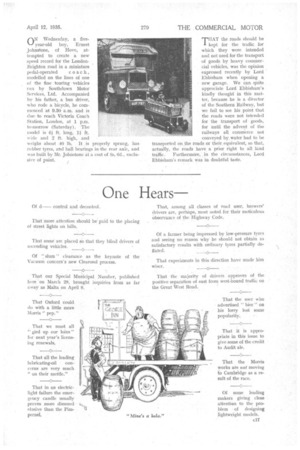Passing Comments
Page 38

Page 39

If you've noticed an error in this article please click here to report it so we can fix it.
AT a garage near our offices, we were interested to learn that since the restrictions as to drivers' hours came into force, many commercial vehicles which garage on the premises each night return much earlier than was previously the case. This has entailed more work for the-garage hands, in that private cars left there for the day have to be moved to make room for the commercial vehicles, which arrive between 5.30 p.m. and 7 p.m. The congestion during this period is considerable, and it is interesting to note the high degree of skill shown by the drivers of the " heavies " in parking their machines in confined Spaces. THE new transparent synthetic resin, Leukon, produced by Imperial Chemical Industries, and shown for the first time in solid form at the Exhibition of British Art in Industry, would appear to present many possibilities. It is about half the weight of ordinary glass, has a good mechanical strength, is insoluble in water and alcohol, although, in certain of its forms, soluble in a number of organic liquids, such as acetone and benzene, and unaffected by acids or alkalis of concentrations up to 40 per cent, in the cases of sulphuric acid and caustic soda. It is an excellent insulator and can be die-pressed without losing its form later.
Wednesday, a five • -/ year-old boy, Ernest Johnstone, of Hove, attempted to create n new speed record for the LondonBrighton road in a miniature
pedal-operated coach, modelled on the lines of one of the line touring -vehicles run by Southdown Motor Services, Ltd. Accompanied by his father, a bus driver, who rode a bicycle, he commenced at 9.30 a.m. and is due to reach Victoria Coach Station, London, at 1 p.m. to-morrow (Saturday). The model is 4 ft. long, 1 ft. wide and 2 ft; high, and weighs about .40 lb. It is properly sprung, has rubber tyres, and ball bearings in the rear axle, and was built by Mr. Johnstone at a cost of Ss. I3cl., exclusive of paint;
THAT the roads should be I kept for the traffic, for which they were intended and not used for the transport of goods by heavy commercial vehicles, was the opinion expressed recently by Lord Ebbisham when opening a new garage. We can quite appreciate Lord Ebbisham's kindly thought in this matter, because he is a director of the Southern Railway, but we fail to see his point that the roads were not intended for the transport of goods, for until the advent of the railways all comMerce not conveyed by water had to be transported on the roads or their equivalent, so that, actually, the roads have a prior right to all land traffic. Furthermore, , in the circumstances, Lord Ebbisham's remark was in doubtful taste.












































































































